Dragging Core2Duo into 2013: Time for an Upgrade?
by Ian Cutress on January 15, 2013 12:30 PM EST- Posted in
- CPUs
As any ‘family source of computer information’ will testify, every so often a family member will want an upgrade. Over the final few months of 2012, I did this with my brother’s machine, fitting him out with a Sandy Bridge CPU, an SSD and a good GPU to tackle the newly released Borderlands 2 with, all for free. The only problem he really had up until that point was a dismal FPS in RuneScape.
The system he had been using for the two years previous was an old hand-me-down I had sold him – a Core2Duo E6400 with 2x2 GB of DDR2-800 and a pair of Radeon HD4670s in Crossfire. While he loves his new system with double the cores, a better GPU and an SSD, I wondered how much of an upgrade it had really been.
I have gone through many upgrade philosophies over the decade. My current one to friends and family that ask about upgrades is that if they are happy installing new components. then upgrade each component to one of the best in its class one at a time, rather than at an overall mediocre setup, as much as budget allows. This tends towards outfitting a system with a great SSD, then a GPU, PSU, and finally a motherboard/CPU/memory upgrade with one of those being great. Over time the other two of that trio also get upgraded, and the cycle repeats. Old parts are sold and some cost is recouped in the process, but at least some of the hardware is always on the cutting edge, rather than a middling computer shop off-the-shelf system that could be full of bloatware and dust.
As a result of upgrading my brother's computer, I ended up with his old CPU/motherboard/memory combo, full of dust, sitting on top of one of my many piles of boxes. I decided to pick it up and run the system with a top range GPU and an SSD through my normal benchmarking suite to see how it faired to the likes of the latest FM2 Trinity and Intel offerings, both at stock and with a reasonable overclock. Certain results piqued my interest, but as for normal web browsing and such it still feels as tight as a drum.
The test setup is as follows:
Core2Duo E6400 – 2 cores, 2.13 GHz stock
2x2 GB OCZ DDR2 PC8500 5-6-6
MSI i975X Platinum PowerUp Edition (supports up to PCIe 1.1)
Windows 7 64-bit
AMD Catalyst 12.3 + NVIDIA 296.10 WHQL (for consistency between older results)
My recent testing procedure in motherboard reviews pairs the motherboard with an SSD and a HD7970/GTX580, and given my upgrading philosophy above, I went with these for comparable results. The other systems in the results used DDR3 memory in the range of 1600 C9 for the i3-3225 to 2400 C9 for the i7-3770K.
The Core2Duo system was tested at stock (2.13 GHz and DDR2-533 5-5-5) and with a mild overclock (2.8 GHz and DDR2-700 5-5-6).
Gaming Benchmarks
Games were tested at 2560x1440 (another ‘throw money at a single upgrade at a time’ possibility) with all the eye candy turned up, and results were taken as the average of four runs.
Metro2033
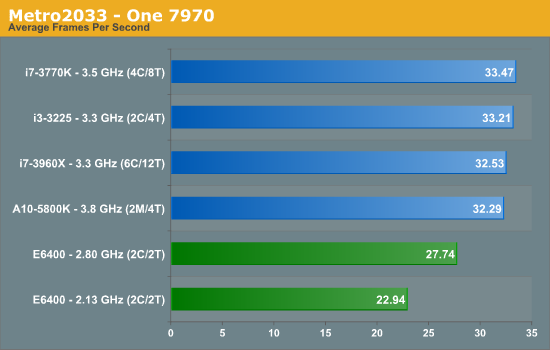
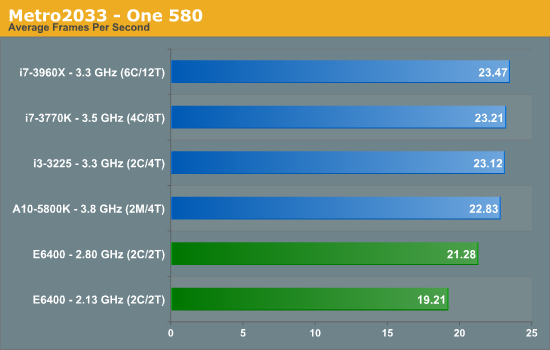
While an admirable effort by the E6400, and overclocking helps a little, the newer systems get that edge. Interestingly the difference is not that much, with an overclocked E6400 being within 1 FPS of an A10-5800K at this resolution and settings while using a 580.
Dirt3
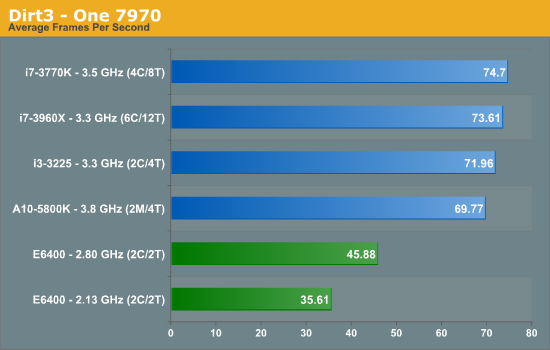

The bump by the overclock makes Dirt3 more playable, but it still lags behind the newer systems.
Computational Benchmarks
3D Movement Algorithm Test
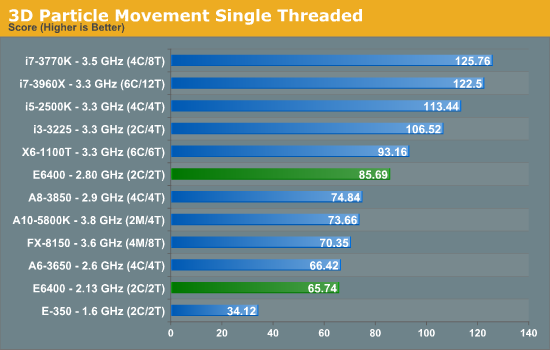
This is where it starts to get interesting. At stock the E6400 lags at the bottom but within reach of an FX-8150 4.2 GHz , but with an overclock the E6400 at 2.8 GHz easily beats the Trinity-based A10-5800K at 4.2 GHz. Part of this can be attributed to the way the Bulldozer/Piledriver CPUs deal with floating point calculations, but it is incredible that a July 2006 processor can beat an October 2012 model. One could argue that a mild bump on the A10-5800K would put it over the edge, but in our overclocking of that chip anything above 4.5 GHz was quite tough (we perhaps got a bad sample to OC).
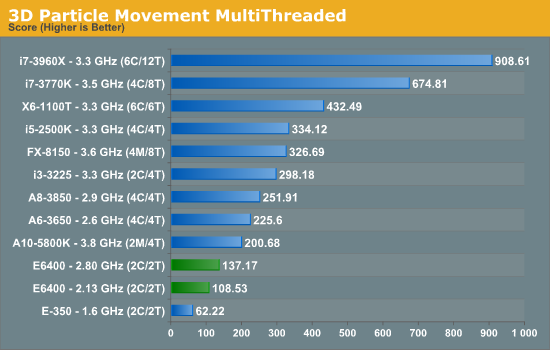
Of course the situation changes when we hit the multithreaded benchmark, with the two cores of the E6400 holding it back. However, if we were using a quad core Q6600, stock CPU performance would be on par with the A10-5800K in an FP workload, although the Q6600 would have four FP units to calculate with and the A10-5800K only has two (as well as the iGPU).
WinRAR x64 3.93 - link

In a variable threaded workload, the DDR2 equipped E6400 is easily outpaced by any modern processor using DDR3.
FastStone Image Viewer 4.2 - link
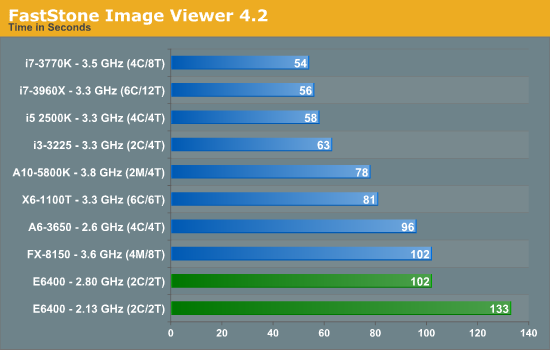
Despite FastStone being single threaded, the increased IPC of the later generations usually brings home the bacon - the only difference being the Bulldozer based FX-8150, which is on par with the E6400.
Xilisoft Video Converter
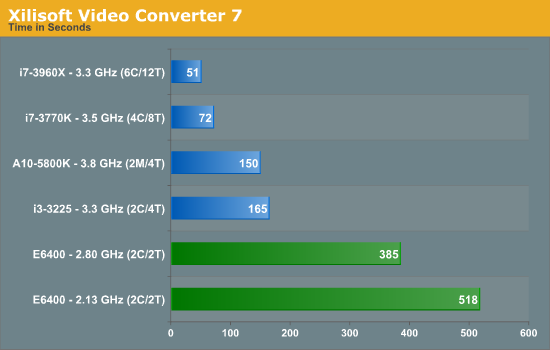
Similarly with XVC, more threads and INT workloads win the day.
x264 HD Benchmark
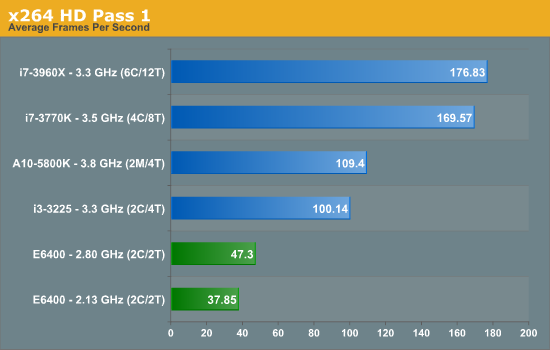
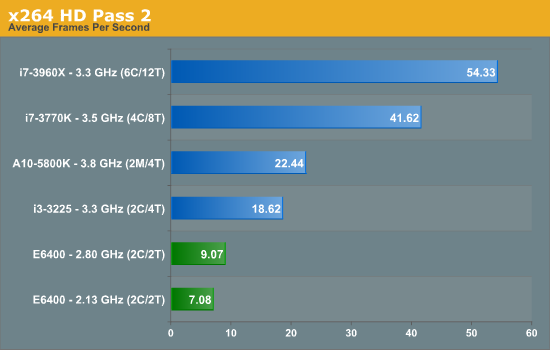
Conclusions
When I start a test session like this, my first test is usually 3DPM in single thread mode. When I got that startling result, I clearly had to dig deeper, but the conclusion produced by the rest of the results is clear. In terms of actual throughput benchmarks, the E6400 is comparatively slow to all the modern home computer processors, either limited by cores or by memory.
This was going to be obvious from the start.
In the sole benchmark which does not rely on memory or thread scheduling and is purely floating point based the E6400 gives a surprise result, but nothing more. In our limited gaming tests the E6400 copes well at 2560x1440, with that slight overclock making Dirt3 more playable.
But the end result is that if everything else is upgraded, and the performance boost is cost effective, even a move to an i3-3225 or A10-5800K will yield real world tangible benefits, alongside all the modern advances in motherboard features (USB 3.0, SATA 6 Gbps, mSATA, Thunderbolt, UEFI, PCIe 2.0/3.0, Audio, Network). There are also significant power savings to be had with modern architectures.
My brother enjoys playing his games at a more reasonable frame rate now, and he says normal usage has sped up by a bit, making watching video streams a little smoother if anything. The only question is where Haswell will come in to this, and is a question I look forward to answering.


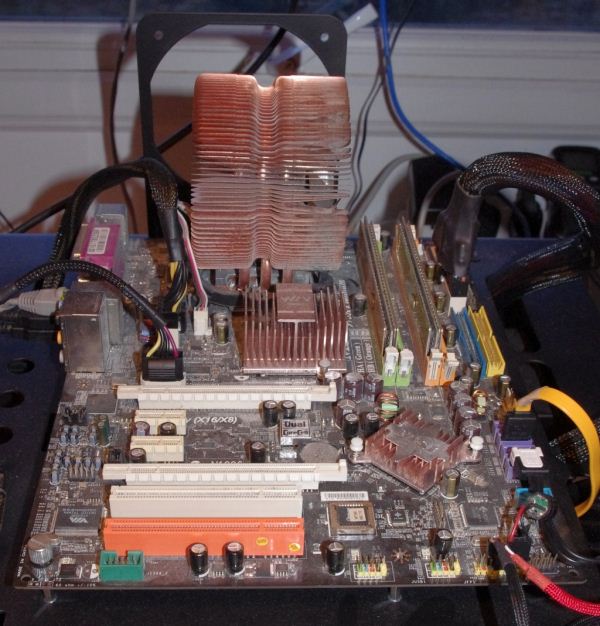








136 Comments
View All Comments
Paulman - Tuesday, January 15, 2013 - link
I'm running a Core 2 Duo E8400 (stock 3.0GHz but oc'd to 3.7GHz) in a system that I bought used off Craigslist for $380 in mid 2010 (it was quite a steal). It originally had an HD 4870 512MB, but that died and I bought a friend's NVIDIA 460 GTX 1GB. It still runs any game I throw at it, usually at High or Highest settings (with or without anti-aliasing, depending on the game) @ 1080p.Core 2 Duo E8400 with 6MB of L2 cache, and overclocked is quite a potent combo. Definitely a powerful performer from that generation, at a decent price. And in single/two-threaded workloads, it's not THAT much slower than today's offerings. It's definitely fast enough to be responsive in day to day tasks (like JS-heavy webpages and Facebook and HD video streaming).
The only area that I REALLY feel the lack of power is in video encoding (which I don't do that much of) and in multi-tasking situations where I'd love to have a full screen Twitch.tv video stream open on my second monitor while playing an intensive 3D game on my main. Not enough cores :P Also, the other time I feel the lack of speed is probably in boot-up and installation of certain things, because I have a Vertex 3 SSD (only in 3Gbps mode, though) which is fast enough to remove the HD bottleneck for most things.
GNUminex - Tuesday, January 15, 2013 - link
I have a similar set up but with an E5200 OCed to 2.7GHz and 2mb L2 and get a similar experience to you. CPU performance is irrelevant for the majority of tasks if you do not have other high end components.Achaios - Tuesday, January 15, 2013 - link
@Ian: I am a big fan of ANANDTECH, and I have read your articles on QX 9650 and X48 motherboards several times.Your article gave me an idea: I am running a QX 9650 @3952 Mhz, DDR2 @1115 MHz and a Gigabyte Nividia GTX 580 SOC (Super Overclock) on an ASUS P5Q Deluxe PCI 2.0 MOBO. Why don't you guys do the same for my QX 9650. I only play WoW and it can hold its own quite well. I play at 1920X1080, all settings at ULTRA.
Here's some gaming benchmarks for my QX 9650:
3D Mark Vantage: P20596 http://img715.imageshack.us/img715/2937/3dmarkvant...
(Note that my GTX 580 is not overclocked. I would score higher if I overclocked it. I don't need to.)
3D Mark Vantage score comparison with other similar CPUS:
http://img545.imageshack.us/img545/8894/3dmarkvant...
3D Mark 11 Pro Score: P6498
http://img21.imageshack.us/img21/5425/pscore39522m...
Memory Performance (Everest Benchmark) Kingston HyperX DDR2:
http://img16.imageshack.us/img16/3858/3953ghzp5qd1...
Pretty sure that mY QX9650 would score substantially higher on a X48 board with DDR3 memory and a higher 4.2GHz OC. Why don't you guys do a similar article on QX 9650 vs modern CPUS and see how much is it worth it to upgrade. I know QX 9650 is one of your favourite chips (you even managed to fry one!).
Just focus on a 1920X1080 resolution or even a bit lower, as really very few people have 2560X1600 monitors.
My system here: http://www.overclock.net/lists/display/view/id/464...
Best regards
IanCutress - Tuesday, January 15, 2013 - link
You might be getting me confused with Rajinder Gill, the previous motherboard reviewer. He tackled X48 - I've never touched a QX 9650 :) Though I would like to. I have some ideas for future articles :)Ian
andykins - Tuesday, January 15, 2013 - link
Just want to add my voice to the chorus that I'd love more of these comparisons in future. :)tipoo - Tuesday, January 15, 2013 - link
A Core 2 Duo from years ago can beat the A10 in single threads? That's gotta hurt. I knew AMD was lacking single threaded performance but I thought they had at least crawled past the Core 2 Duo.My laptop is a Core 2 Duo t6500 (2.1GHz Penryn), and while I would definitely want something more for gaming, I must agree that it is still plenty capable for what the vast majority of people do on the computer. A few die shrinks down the road, when Core 2 Duo like power becomes the standard for smartphone/tablet power, I think desktops and laptops will start to shrink at an even faster rate than they are now. Some will still need them of course, like some need trucks, but for the majority a tablet will do just as well.
IanCutress - Tuesday, January 15, 2013 - link
The older Stars cores performed much better in single thread, as shown by the X6-1100T, and the OC'ed E6400 only beat the A10-5800K at stock in a single non-memory related benchmark. Just to put it in perspective ;)Ian
IanCutress - Tuesday, January 15, 2013 - link
*Thuban on the X6-1100T, Stars on A6-3650cosminmcm - Wednesday, January 16, 2013 - link
Even if Stars/Thuban perform better than A10, they still won't touch Core 2 per clock:http://www.anandtech.com/bench/Product/88?vs=48
althaz - Tuesday, January 15, 2013 - link
I too had a launch-model Core 2 Duo, the E6300 (1.86Ghz at stock). I was running it a bit faster (3.29Ghz), but had definitely started to notice it's age (GTX260 for graphics, 8Gb of DDR2).I opted for a whole new PC in May (it was nearly GPU upgrade time, I wanted an SSD and I was sick of my old case) and the speed difference is actually quite astounding. A lot of the general responsiveness I put down to the SSD, but photoshop, gaming and compiling all got significantly faster with the upgrade to a 4Ghz Ivy Bridge quad core.
I gave my old computer away and the mate I gave it to was pretty stoked (he had a Pentium 4 and a Radeon 1950 or something like that), but I couldn't be happier that I've upgraded.
I only upgrade my CPU/Mobo every four-five years (with other upgrades as needed) and the difference when changing to the newer platform is always very significant.